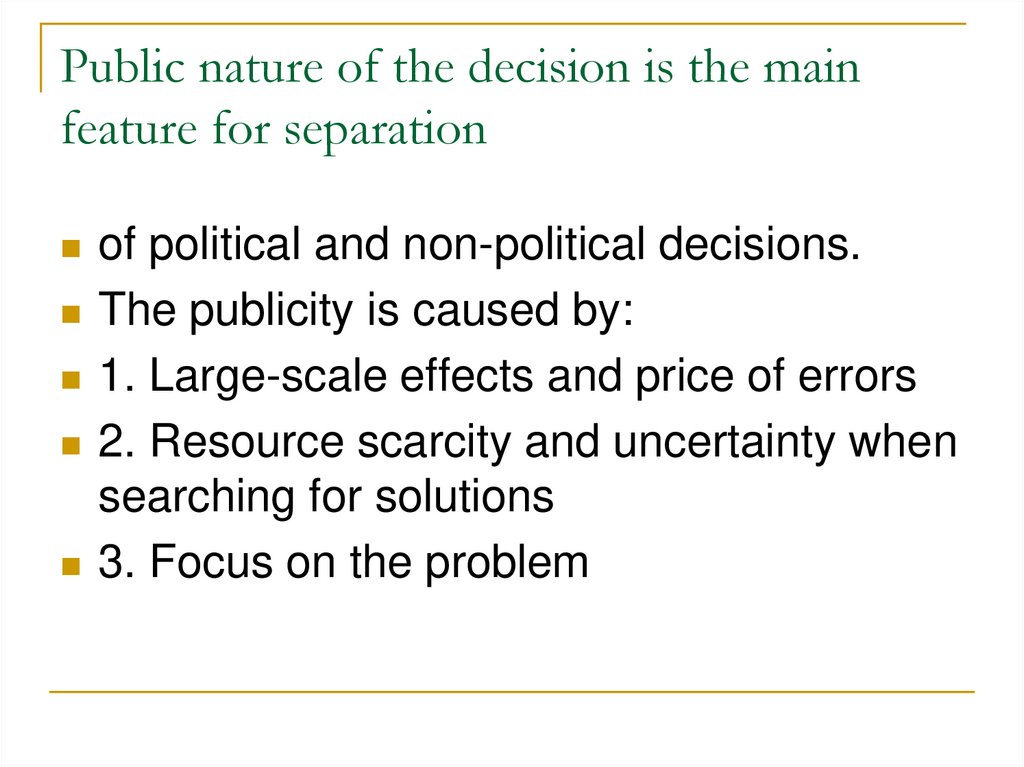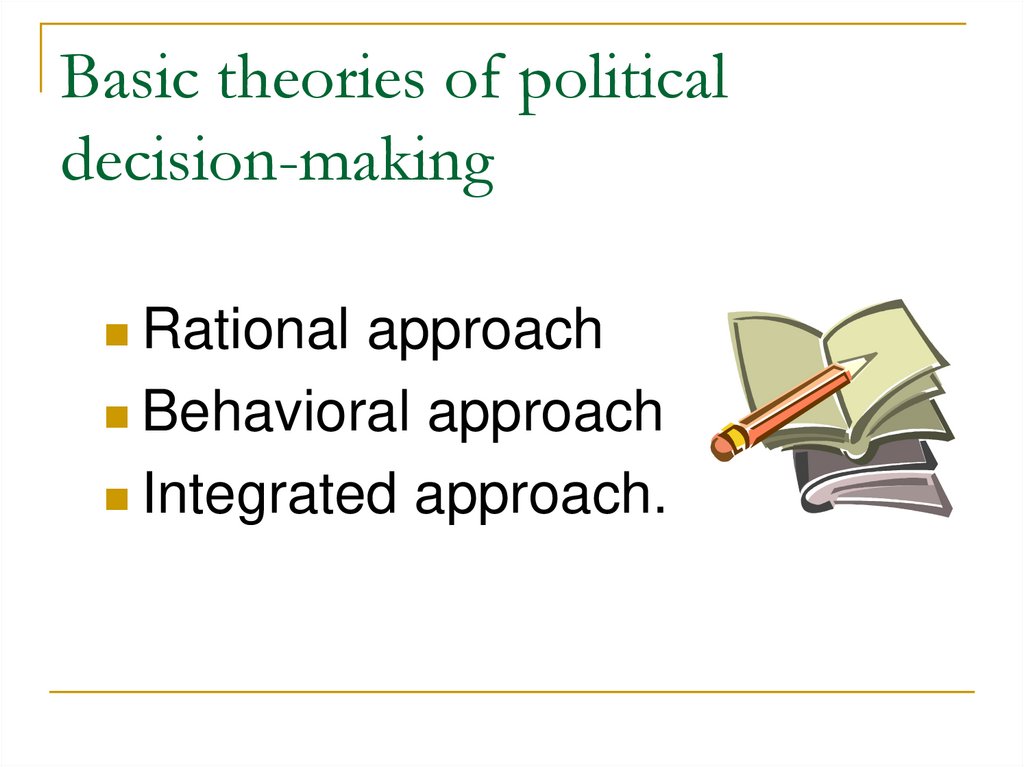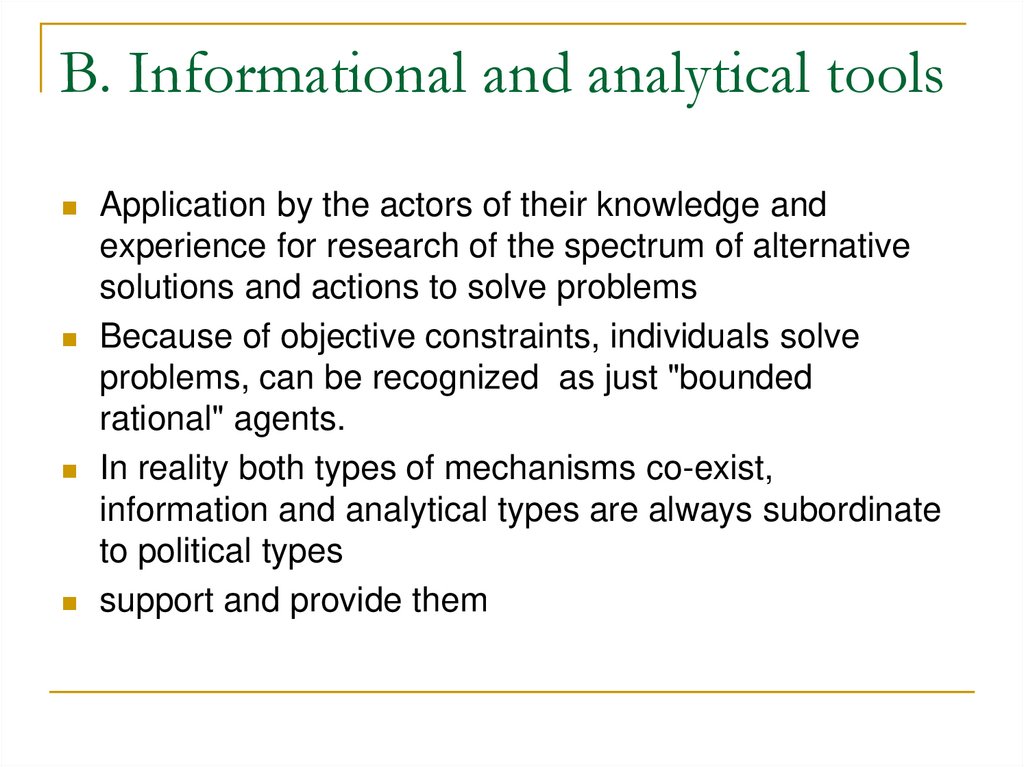Похожие презентации:
Political Analysis: The Problem of Relation of Qualitative and Quantitative Methodologies
1. Political Analysis: The Problem of Relation of Qualitative and Quantitative Methodologies
2. Structure:
1. Basic measures of political analysis.2. General characteristics of the PA, the
difference from other social sciences
3. Concept of R- and Q- methodologies
4. Directions and types of political
analysis
5. Political decisions as an object of
analysis
6. Value conflicts
3. 1. Basic measures of political analysis
The concept of “PoliticalAnalysis" is used today in
three meanings:
1. Theoretical and
fundamental
2. Instrumental and
empirical
3. Practical and applied
4. First, theoretical and fundamental meaning of Political Analysis
covers basic conceptual studies of politicalsphere, its structure and dynamics
In such interpretation, this concept is almost
synonymous with the category of
"fundamental (theoretical) political research"
in general.
“Analysis of Political Structure" of D. Iston
[1990]
"Modern Political Analysis“ of R. Dal’ [2003]
and others are written such a way.
5. Second, instrumental and empirical meaning of Political Analysis
Collection and description, classification andprocessing of primary data.
This aspect of political analysis has already
acquired an institutional character within the
political science and is identified as a new discipline
"Methods and Techniques of Political Research"
Sometimes it is called “Empirical Political Analysis"
(EPA) or “Research Methodology and Techniques
of Political Science."
6. If in the theoretical direction
basic analytical unit is the "concept“reflecting causal, functional, and other links
"inside“ political process,
То в инструментальном подходе исходной
единицей выступает “данное”, т.е. Then in
instrumental approach, the original unit is
"given", i.e.
primary information about a particular event
in the political life
7. Third, practical and applied measurement of Political Analysis
The foreground is not building a harmoniousand well-founded theory and
not collecting data set,
but ways to estimate and solve social
problems for a specific customer,
as a rule, one of political actors.
8. In applied policy analysis (APA)
often deduction and induction are combined.Although the "grasping the picture immediately" style
of thinking dominates,
in contrast to “Theorist” constructing abstract models
of policy, and
"Toolmaker“ engaged in operationalization at the level
of empirical data,
“Applied Researcher” builds a working model of the
unique problem situation, borrowing conceptual
knowledge from “Theorist”, and factual information
from “Toolmaker“
9. Therefore, for “Applied Researcher"
Therefore, for “Applied Researcher"prescriptive function
(prescription) prevails
whereas for “Theorist“
explicative function
(explanation) prevails
and for "Toolmaker" descriptive function (description)
prevails
10.
Parameters ofMeasurement
Fundamental
(FPA)
Defining vector Deduction
Empirical
(EPA)
Applied
(APA)
Induction
Retroduction
Nature of
Knowledge
Role of
Modeling
Abstract and
theoretical
Specific and
factual
Development
of conceptual
meta models
Use of models’
characteristics
Synthetic and
projective
Construction of
the problem
and situation
models
Basic Analytical
Unit
Concepts
Data
Problems
Dominant
Function
Explictive
Descriptive
Prescriptive
11.
CriteriaFundamental Research
Applied Research
Functions
Cognitive:
cognition of relations,
mechanisms, regularities
Converter: use of cognized
mechanisms
Role of the
subject of
analysis
Objectified (detached
neutral)
Subjectivized (active
concerned)
Connection of
theory with
practice
Indirect
Direct
Phase of
cognitive cycle
From the collection of
empirical data to abstract
theoretical models
From theoretical models to
their specific synthesis into
practical technologies
Attitude to space
and time
“Soft” spatial localization and "Rigid" spatial localization
limited time
and strictly limited time
12. 2. General Characteristics of APA, Difference from Other Social Sciences
2.1.Client-orientation problem,2.2. Heterogeneity of conceptual and
methodological framework
2.3. Instrumental multiplitsizm,
2.4. Combination of empirical and
normative approaches
13. 2.1.Client-orientation problem
Traditional social sciences - sociology, politicalscience, psychology, economics - have clearly
defined subject areas, research facilities and
methods of scientific schools and theories.
In political analysis such "manufactory-guild"
specialization is simply impossible , both because
of multidimensionality of the researched problems
and organization of applied research
A customer does not need a multivolume
monographic work, and the specific conclusions
and practical recommendations.
14. 2.2. Heterogeneity of conceptual and methodological framework
Political analysis is rather "cosmopolitan" inrelation to conceptual approaches and
principles, borrowing them from a variety of
social, human, and even natural sciences
For example, to analyze the totality of the
consequences of the US military campaign in
Iraq in 2003 for the Russian policy
one need to involve conceptual knowledge of
the theory of international relations,
international economics, military science,
sociology, history, psychology, statistics, etc.
15. Methodology of Political Analysis consists of
elements of set of disciplines: political science, sociology,psychology, economics and philosophy.
Conceptual apparatus of modern political analysis is the study
of “inputs", “outputs", "conversion", the content of political
course and decision-making process
has been formed on the basis of the system theory.
Political analysis is indebted to philosophy of the
epistemological concept of "problem-solving“,
as well as of ethical principles included in the manuals and
codes of practice analysts
16. 2.3. Instrumental multiplitsizm
main methodological setting of critical multiplitsizm is theprinciple of triangulation,
according to which the analysts who seek to deepen
politically relevant knowledge should use a variety of
measurements, techniques, tools, sources of information and
means of communication“ (Dunn 1994).
Need in multidimensional principles, approaches and tools is
due to the increasing complexity of social and political
problems,
as well as the complexity of the decision making process,
which now involves both state actors
and pressure groups, social associations, local communities,
etc.
17. 2.4. Combination of empirical and normative approaches
To prepare recommendations to the client, the analyst mustnot only describe, explain and predict the political
developments,
but also to evaluate recommendations based on certain
criteria values.
Therefore, unlike the basic sciences where these
approaches are often separated
in APA the empirical approach (to answer the question:
what is happening and will happen?)
is inevitably combined with standard approach (when
answers to the questions: Will it be worse or better? or
What to do next? are searched )
18. Place of Political Analysis in the structure of the policy process
АAnalysis of the
problem and
decision
Problems
+
В
+
Decision-making
Alternatives
Solutions
Problem situation
С
Implementation
of decions
Actions
19. 3. Concept Q- and R- methodologies
Today there is a confrontation betweenadherents of the so-called R-methodology, i.e. the
traditional practice of the present political science
positivist approach,
based on the principle of scientific objectivity and
(mostly) accurate, quantitative methods, and
adherents post positivist Q -methodology, which is
built on the principles of value criticism and involves
consideration of subjective factors and active use
along with math, qualitative methods.
Positivist R-methodology today is still dominant.
20. At the root of the Q-methodology
was an English mathematician G.Tomson,first pointed to the possibility of "inverted" factor
analysis,
aimed at identifying the correlation between
individuals,
but not between their quantitative
characteristics.
He first proposed the use of the letter Q to
indicate the new technique
21. The ancestor of Q-методологии
is considered to be another British scientist physicist and psychologist V. Stefenson.In 1935 he published in "Nature” magazine a
letter where he revealed the mathematical
side of the "inverted" factor analysis, and
showed how it could be used in research
Today V. Stefenson works in psychology,
sociology, social psychology, political
psychology and political science
22. Correlation of R- и Q- methodologies
Classic factor analysis is a procedure toestablish the relationship between the
characteristics of a certain set of objects
(R-method).
Within the R-methodology factorization is
happening inside the columns of the table.
In a first approximation, Q-method can be
defined as a matrix factorization of the
same data, but in inside its series.
23. Such a procedure is feasible only
to the uniformity of units, represented inside the row fixingthe following rates: income (in rubles), location (distance
from the capital in kilometers), education (number of years
spent at the university), etc.
"Inverted" factorization is not possible, because you can not
say what is more - five years of the university, or a million
rubles in annual revenue.
However, Stephenson found the way of unification in a row
of characteristics, proposing to measure the "weight" of
each phenomenon in terms of subjective importance.
Each individual must decide what is important - the annual
income of one million rubles or the higher education
24. Q- and R-methodologies reflect
different directions in philosophy of scientificresearch.
The purpose of R-methodology is to give scientists
an objective knowledge of the subject, which allows
to include it in the scope of the positivist
epistemology.
Q-methodology is considered to be post positivist,
since its use suppose a doubt in the absoluteness of
cognitive significance of "objective" technique along
with the interest to what is hidden behind the veil of
objectivity.
25. In accordance with the Q-approach
A person is conceived as an integral being, notreduced to the simple sum of his(her) individual
characteristics.
Researcher here is not an "impartial spectator“,
but
a partner actively "implanted" in the individual
world perception (D. V. Goncharov, 2002)
26. 4. Directions and types of political analysis
A. A. Degtyarev allocates 4 approaches todefining areas of APA:
Structuring of the APA subject field is being
conducted on the following criteria:
4.1. Functional tasks and phases of political and
analytical activities;
4.2. In accordance with the scope and objects of
political analysis;
4.3. Based on the methodology used by experts
and their tools
4.4. In relation to the time factor
27. 4.1. Functional tasks and phases of political and analytical activity
modeling and structuring the problemsituation,
data collection and its descriptive analysis,
situational diagnosis,
forecasting trends of political development,
development of management
recommendations and, finally,
evaluation of political activity
28. 4.1. Variants of data classification
Dunn writes about the five types offunctional and procedural types of APA
(structuring of the problem, forecasting
situation, recommendations, monitoring
of shares and evaluation of their
results) (Dunn 1994)
Hogwood and Gunn write about three
(research of "inputs", "content" and
"outputs" of the political process)
(Hogwood, Gunn 1984)
29. 4.1. Separate areas within the APA
policyforecasting
decision analysis
impact analysis
policy planning
30. 4.3. Classification on methodology of an expert and his tools
on the basis of methodologicalschools, dominant in social and
political science:
system,
rational choice,
neoinstitutional,
bihevioralist
31. 4.3. Classification based on research methods:
event analysis,risk analysis,
political marketing,
evaluation studies, etc.
In recent years on the basis of this
classification is division into R- and Qmethodologies,
especially as it directly affects the ratio in
the research of quantitative and qualitative
methods.
32. 5. Political decisions as an object of analysis
Political decisions and actions toimplement them The main factor, characteristic of
relations of political system with the
external environment,
Result of its activity,
Which is criteria for evaluating the
effectiveness of the fundamental
institutions of power
33. Development and decision-making
This is mechanism of the transformation ofpublic requirements
into public generally binding regulations,
regulatory relationships and determining the
distribution of power resources in the society
to solve politically significant problems
34. Public nature of the decision is the main feature for separation
of political and non-political decisions.The publicity is caused by:
1. Large-scale effects and price of errors
2. Resource scarcity and uncertainty when
searching for solutions
3. Focus on the problem
35. Sometimes «decision making» and «policy making» concepts are divided
“Decision making” - “political decisionmaking” is choice situation, involvingrational action and sanctions
“Policy making” – “forming of policy” is the
process of collective, mutually intersecting
solutions
in the absence of a subject capable to
make decisions on behalf (and binding) of
the parties involved.
36. Components of information important for policy-making:
1. Political problems2. Policy options
3. Political actions
4. Political results
5. Political restrictions
37. Basic theories of political decision-making
Rationalapproach
Behavioral approach
Integrated approach.
38. Rational approach is a classic way of understanding
Of the political decision-makingBased on microeconomic methodology
Perceived effectiveness as the highest value
The purpose is to maximize the “output"
(benefits) for a given level of "input" (costs).
Or minimize costs for a given level of benefits
39. The decision-making process is divided into five steps:
1. Defining purposes2. Identification of alternatives
3. Evaluation of the effects
4. Choosing a solution
5. Return to the starting position
40. Problems in the rational approach:
A. The problem of informationRational approach has high requirements
to reliability.
Information needs of type rational
methods often can not be met by available
resources
Or exceed the capacity of the limited
human rationality
41. B. The problem of values (external constraints)
Rational approach avoids answering the question who and how determines the purposesIt is assumed that this has already happened at the
"superior" level of decision-making
In reality, parts and bodies at the "top" differ in the
understanding of the stated objectives, but also the
subject of the decision-making torns between
purposes from interest groups and categories of
clients of "below“ level
The result - often technically correct solutions - are
politically "no-go"
42. B. The problem of values (inherent limitations)
Sample calculation, for example, totransfer benefits and costs in monetary
terms
or for the weight values of alternatives
can hide implicit value priorities behind
strict formulas
in fact, the method will serve group and
individual interests
43. Behavioral approach in response to the shortcomings of rational purpose
Purposes, considerable at decision-making,never, or almost never can be defined as
clearly as rational approach requires.
Political purposes "of course, are characterized
by the following features:
they are multiple, contradictory and ambiguous"
A.Vildavski 1973
44. Purposes in a pluralist political system
are periodically formulated and vary dependingon the configuration of the political majority,
demographic shifts occur.
New knowledge and technologies are changing
the very nature of the problems and our ability
to solve them
45. Moreover, the main task at political decision-making
Is formation of support of the majority.Suppose that vague character of purposes
and ambiguities.
The criterion of the best solution is
practical possibility of reaching agreement on
this decision by all stakeholders.
"There is no other way to confirm the validity
of the policy purposes other than the very
existence of public consensus”
Charles Lindblom, 1959
46. “Possible to make mistakes and improve them” as an advantage
Models of the behavioral approachDecision-making mechanisms "should be
designed in such a way that errors are visible
and correctable, notable and reversible, and
therefore cheap and acceptable" (A.Vildavski,
1979)
Incremental solutions, allowing the possibility of
correction, have a better chance of mobilizing
political support
47. Integrated approach
Suggests that the politicaldecision-making is the
result of interaction of
A. Political and
B. Information and
analytical tools
48. A. Political mechanisms
Refer to the values and interests,Influenced by political actors who are in a
competitive relationship over the distribution of
resources
They identify ways to harmonize the interests of
participants of the political process
And also the ways of transformation of values
and interests of the participants into the
purposes of political organism on the whole
49. B. Informational and analytical tools
Application by the actors of their knowledge andexperience for research of the spectrum of alternative
solutions and actions to solve problems
Because of objective constraints, individuals solve
problems, can be recognized as just "bounded
rational" agents.
In reality both types of mechanisms co-exist,
information and analytical types are always subordinate
to political types
support and provide them
50. 6. Value conflicts
M.Munger allocates 5 forms of analysts’conflict:
The conflict between loyalty to the client and
own principles
The conflict due the constraints set by the
client in respect of the matrix
criteria/alternatives
The conflict between the need for analytical
accuracy and deadlines of works
The conflict over the corporate limits of the
professional community
Conflict due to resource constraints
51. Three types of liability of analyst
Scientificcommunity
Client
Analyst
Civil
society
52. Three alternatives of the conflict: protest, output and disloyalty
ObjectionResign
Ultimatum
Protest
Output
Resign and
exposure
Leak
Disloyalty
Sabotage
53. Terms of moral justification for disloyalty (Peter French, 1983)
All possible means of protest within theorganizational structure must be exhausted
There should be a conviction in violation of
procedural, legal, political or ethical standards
And that such violation will have negative
consequences for society.
We must be prepared to back up all the
accusations with unambiguous evidence





















































 Политика
Политика








